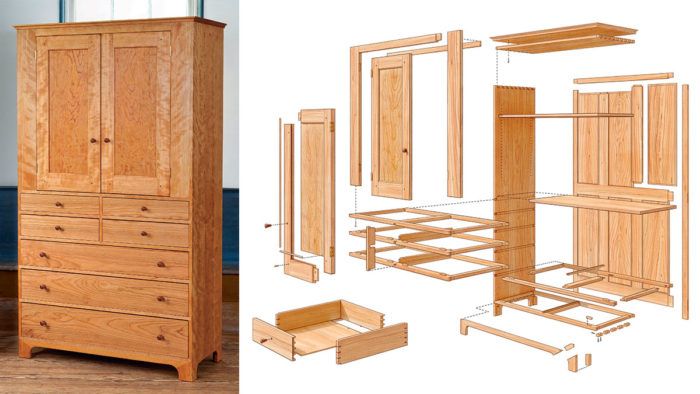Classic Shaker Cupboard with project plans
Handsome storage cabinet is comfortable in any room
Synopsis: This large Shaker piece combines a cupboard and a chest of drawers. The carcase is straightforward dovetailed construction with a three-sided face frame added to the front. The drawers feature traditional hand-cut dovetails and the frame-and-panel doors use pinned mortise-and-tenon construction. A simple but effective center guide supports the three widest drawers and prevents them from binding. Details such as adjustable shelving, a mitered base, a frame-and-panel back, and a cove profile on the top complete the piece.

In FWW #206, I wrote about a low chest of drawers and focused on its case construction, drawer runner system, and using a shopmade jig and router to cut dadoes and dovetail slots in the carcase. Since then, a client asked me to build a large Shaker cupboard to use in a kitchen.
This piece (and this article) picks up where “Shaker Chest of Drawers” left off. I’ll expand on how I approach Shaker casework, showing you how to apply the three-sided face frame to the front. I’ll also walk you through how I fit and install drawers. Also, because the drawers are so wide, I included a simple but effective center guide that keeps big drawers from binding.
The way I approached the doors is appropriate for almost any Shaker piece, so the editors gave that technique its own spotlight (see “Frame-and-Panel Doors Made Easier,” pp. 54-57). By the way, because this piece will live in a kitchen, I sized the drawers to hold cutlery, kitchen linens, and even pots and pans. But this classic storage piece can be adapted to any room of the house. That’s what the Shakers would have done.
Large panels can be a challenge
Other than the size of the panels, the carcase construction on this piece is almost the same as the low chest in FWW #206. There are a few differences: Because of the size of the pieces, I used a jigsaw instead of a bandsaw to cut the arches into the bottoms of the two sides. This chest has a permanent middle shelf that the low chest doesn’t, and, also because of the size of the pieces, I got creative about dovetailing and how I transferred the tails to the pin boards. I laid out and cut the tails first on the subtop, then moved to the halfblind pins on the sides. I rested the long workpieces on the ground and tacked the top in place with a small brad, creating a freestanding inverted U. I stood on a stool to transfer the tails to the pin board, and then cut the pins at the bench.
For the full article, download the PDF below:
From Fine Woodworking #218
Fine Woodworking Recommended Products

Circle Guide

Drafting Tools

Compass























Comments
This looks like a great project, but I have a few questions:
Did the Shakers make this with adjustable shelves, and if so, would the have used wooden pegs instead of pins or would they have used notched vertical sticks or some other mechanical method to allow for adjustable shelves? I look forward to building this cupboard.
Good question.
https://www.finewoodworking.com/1996/10/01/supporting-shelves
Love the overall form and the build itself, not a huge fan of a dowel functioning as a drawer guide.
Log in or create an account to post a comment.
Sign up Log in